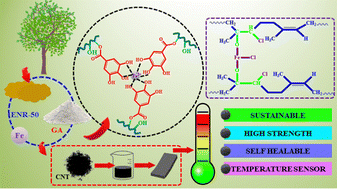Synthesis of gallic acid-grafted epoxidized natural rubber and its role in self-healable flexible temperature sensors†
Abstract
Developing a flexible temperature sensor with appreciable sensitivity is critical for advancing research related to flexible electronics. Although various flexible sensors are available commercially, most such temperature sensors are made from polymeric materials obtained from petrochemical resources. Such sensors will contribute to electronic waste and increase the carbon footprint after usage. While there are reports on various sensors made from sustainable polymers, research related to developing self-healable flexible temperature sensors made from sustainable polymers is significantly less. Herein, we report on developing a flexible temperature sensor made of gallic acid-grafted epoxidized natural rubber and multi-walled carbon nanotubes. Various spectroscopic and thermal techniques vetted the modification of the epoxidized natural rubber. The highest grafting of 20.9% was achieved in the selected window of stoichiometry. A self-healing behavior was achieved by leveraging the FeCl3 based metal–ligand crosslinking of the composite. The healing efficiency was noted to be 31.2% for the composite material. The fabricated sensor demonstrated an electrical resistance of 4.46 × 103 Ω, thereby warranting the composite to demonstrate an Ohmic behavior in the I–V plot. Appropriate data fitting suggested a variable range hopping mechanism as causation towards excellent electrical conduction. The temperature sensitivity and the thermal index of the developed sensor were noted to be −0.17% °C−1 and 781.2 K, respectively, in the temperature range of 30 °C to 50 °C. The proposed method of fabricating sustainable, high-strength, self-healable, and robust temperature sensors and conductors is a unique and value-added approach for next-generation flexible electronics.



 Please wait while we load your content...
Please wait while we load your content...